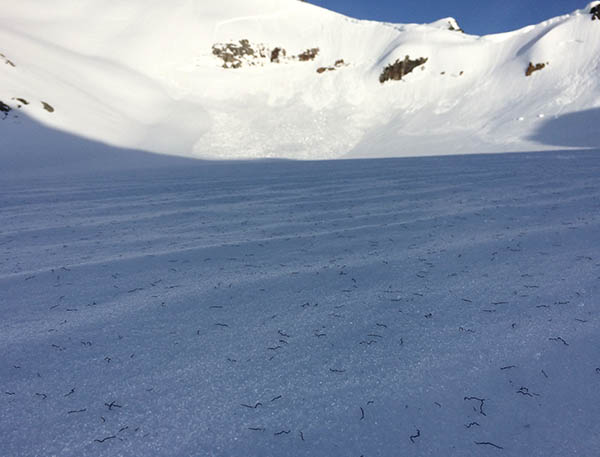My partner John and I were planning to camp at Ingraham Flats, a nice bench on the Ingraham Glacier at 11,000 feet, just above Mount Rainier’s Camp Muir. We hoped to get a head start on the crowds eyeing the Disappointment Cleaver, Rainier’s busiest climbing route, the following morning.
It was getting late—almost time for a headlamp. We stopped to put on a layer and that’s when I saw them. Worms. On the glacier. I said something insightful to John, like “Dude, what are all these worms!?” John grew up in Tacoma and was a seasoned northwest climber. He laughed at my surprise. “Those are ice worms.” Squatting down, I picked up some snow for a closer look. The ice worms wriggled around, seemingly unperturbed. I was smitten. John said he thought they only lived in glaciers (he was right) and that they ate “watermelon snow,” which is a common name for the green algae that blooms on glaciers and snowfields in summer (right again).

If you spend enough time on glaciers in the Northwest, you’ll encounter ice worms, too. Formally Mesenchytraeus solifugus, ice worms are the only worm on Earth known to complete its entire life cycle in ice. And ice worms don’t just tolerate their icy world; they thrive in it. Back-of-the-envelope estimates of ice worm abundances on a single glacier can venture into the billions. Ice worms are small—you could fit several on a dime—but they are easy to spot, thanks to their brown pigmentation. Being dark on a very white, reflective surface seems like a bad idea since any predator could spot them easily, like rosy finches do. We biologists think it’s a UV protectant, and more pigment means less UV damage. Human skin tones have evolved in the same way.
Ice worms can be found on coastal glaciers from the Sisters in Oregon to the Chugach Range of Alaska. This distribution is somewhat puzzling, however, because while there are plenty of more interior glaciers, none have ice worms. It turns out, this may be because ice worms aren’t just cold-adapted; they are stenothermal, which is a fancy way of saying they only tolerate a very narrow range of temperatures.
If you pick up an ice worm with your bare hand, it will essentially melt before long. But, somewhat ironically, ice worms can also freeze to death if they get too cold. A recent study showed that ice worms do not inhabit glaciers where over-winter temperatures at the previous summer ice surface fall below -7 degrees Celsius. This lack of extreme cold tolerance is likely the key factor limiting ice worms from colonizing inland glaciers, where less insulating snow and colder temperatures make conditions untenable.
Looking back, I owe a lot to these little worms. When I first encountered an ice worm, I was young, excited, and close to finishing a degree in Zoology. But I didn’t know what I wanted to do next. Ice worms were my gateway to a world of life on alpine glaciers, an icy biome with more questions than answers. As climate change proceeds and glaciers recede all over the world, one looming impact of deglaciation is the concurrent loss of their icy inhabitants.
So next time you find yourself on a glacier on a calm, summer evening, have a look around for your squirming, ice-loving hosts. They might change your life. Or, if you don’t happen to be an impressionable kid like I was, ice worms will at least give you a new perspective on the life inhabiting one of Earth’s most extreme biomes. // (Scott Hotaling)
A former Mount Rainier climbing ranger turned alpine biologist, Scott Hotaling studies climate change in mountain ecosystems. You can learn more about his research at www.coldgenomes.com or follow him on Twitter: @mtn_science.
[Feature photo: Ice Worms // Rachael Mallon]













